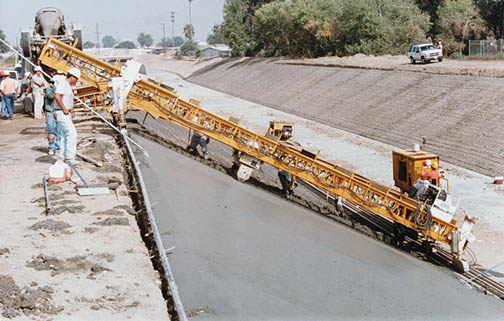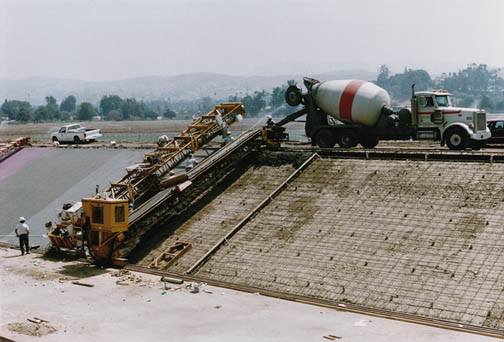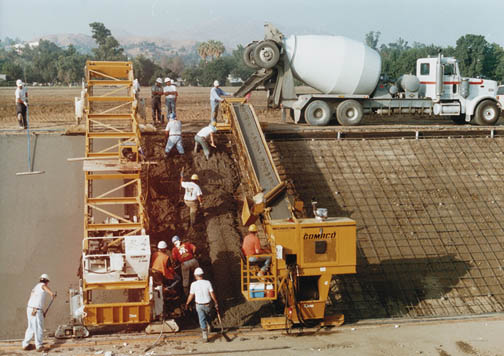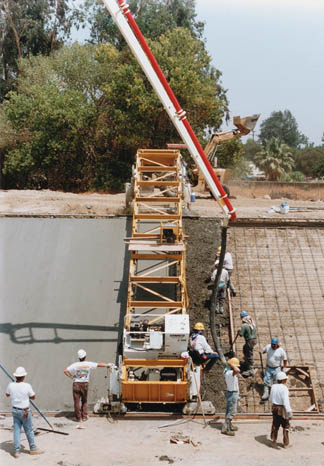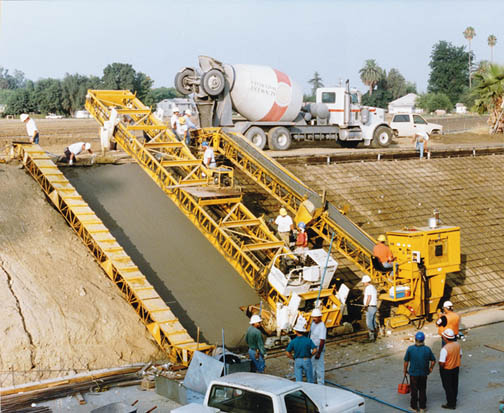GOMACO World Index --- GOMACO World 27.2 - April 1999
San Timateo Creek Flood Control
San Timateo Creek has flooded its banks for the last time. The creek, located in Loma Linda, California, had a history of breaking through its flood control banks and, because of increasing population in the area, the flooding had to be stopped.
E.J. Salgado, Inc., subcontractor to E.L. Yeager of Riverside, California, was in charge of enlarging the creek channel and lining it all with concrete. The Army Corps of Engineers oversaw the project.
Lalo Salgado and Ed Vadnais, Jr., owners of E.J. Salgado, Inc., bought a GOMACO C-450 cylinder finisher with the slope paving conversion package for the job. They had researched the C-450 previously for a job in the Palm Springs area.
"We started doing the research on the paving machines," Vadnais explained about the Palm Springs job. "We considered the C-450 because of its reputation, reliability, cost, and it fit the requirements of the job."
They failed to acquire the project, but then the San Timateo Creek project came up.
"We had all the information in mind and when this project came about, we already knew pretty much what we needed and the approximate cost of what that would be," said Vadnais. "When we successfully acquired the project, we made contact with Nixon-Egli, our dealer, and wound up purchasing the machine for this job."
The six month project consisted of approximately 3.22km (two miles) of flood control channel that was a combination vertical wall channel and trapezoidal channel. Slopes were poured at 1.5:1 and 2:1 and ranged from 5.49 to 11.58m (18 to 38 ft) on the diagonal length.
The bottom of the widest section of the trapezoidal channel was approximately a 9.75m (32 ft) wide invert. The vertical wall channel, at its widest point, was 18.29m (60 ft).
According to Vadnais, the GOMACO RC Conveyor (RC 240-24) was used to place concrete about 80 percent of the time on the slopes. All the inverts had to be pumped because the top of the channel was approximately 30.48m (100 ft) and too wide for their model of conveyor to span.
Concrete thickness and mix design was Corps of Engineer specified. On the slopes, a 25MPa (3500 psi) mix with a 25mm (one inch) aggregate was used. The inverts were the same 25MPa (3500 psi) strength with 38mm (1.5 in) aggregate. All slopes were 203mm (eight inches) thick.
The Corps also required the use of vibrators for concrete consolidation. "All of the Corps' samples exceeded their design strength requirements," Vadnais added.
Other Corps requirements created additional challenges to the project when the weather refused to cooperate.
"We had one of the hottest summers going," Vadnais explained. "A large percentage of the concrete we were pouring had ice added to the mix to keep the temperature down because they had very tight specifications on concrete temperatures. I would say probably 50 percent of the concrete we poured was mixed with ice. Probably another 25 percent was mixed with chilled water on the days that were a little bit cooler."
Vadnais noted how the C-450 helped them overcome other challenges. "We actually paved through a 2:1 to a 1.5:1 transition where there was also about a 1.83m (six foot) change in width of the pour in the middle of it because of the change of the slope. We actually poured through it with the machine. It probably should have never worked, but we were able to do it," said Vadnais. "We have power widening on the machine, which I really think helped us in that fact."
Average production varied. When pouring the slopes, they averaged 229-268m3 (300-350 yd3) per day. Invert pours got as high as 612m3 (800 yd3) per day. Approximately 20 pours were required to complete the slope paving.
"Every day that we poured we produced more than we had on any previous day," said Vadnais. "On the last day, we poured at least twice as much as we did on the first day. That first day it took us twelve hours to pour and on the last day we did it in seven. We decreased the amount of time by about 40 percent and doubled the production."
Vadnais also explained their average slump on the project. "We usually pour it about a 76mm (three inches)," he said. "With a 2:1 slope, you can pour about three, but a 1.5:1 slope you've got to get down to 63 to 50mm (2.5 to 2 in) to hold them. It's what we found in the mix designs we were using."
The Corps of Engineers required the concrete be gone over once with a steel trowel and then broom finished. Four to five finishers were used behind the C-450. Joints were set in-form only after the pour at the end of the day.
Since the channel paving project, E.J. Salgado, Inc., has used the C-450 and RC Conveyor on bridge decks and other paving jobs. Vadnais described how easy the C-450 is to reconfigure and set-up, even for small jobs.
He went on to explain a two-day paving job they did in Orange County. "We brought the machine in after pouring a bridge deck, changed it to a slope configuration, and had it ready to go on the slope in a period of about three hours," he said.
The job was a 183m (600 ft) section of slope 1.5:1 that had to be a checkerboard pattern. Each day they poured approximately seven hours.
"A 183m (600 ft) job is not that big of a job and we found it cost effective to use the C-450. We made good money with it, even with the set-up, transport, and reconfiguration of the machine," Vadnais said. "We would never consider the C-450 just being used on long-term projects."
E.J. Salgado, Inc., founded in 1996, is located in Alta Loma, California. Lalo Salgado is president/CEO and field supervisor and Vadnais is the secretary/treasurer. They specialize in flood control channels, concrete structures, and bridge work in Southern California.
"We've had no regrets about buying the C-450 and RC Conveyor and see nothing but upside with owning these two machines," Vadnais said.
After experience with the C-450 in various applications, Vadnais summed up what he thought about the machine. "We like it very much. When we first looked at it, we wondered what the heck we were going to do with it," he said. "It's a very good, useful machine. In the right application, there's nothing that will beat it."
Subscribe to Receive GOMACO World Magazine
